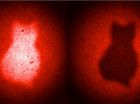Sensory-tested drug-delivery vehicle could limit spread of HIV, AIDS
2014-08-28
(Press-News.org) A unique method for delivering compounds that could positively impact the global battle against HIV and AIDS may be possible, thanks to researchers in Penn State's College of Agricultural Sciences.
A semi-soft vaginal suppository made from the seaweed-derived food ingredient carrageenan and loaded with the antiviral drug Tenofovir provides a woman-initiated, drug-delivery vehicle that can protect against the spread of sexually transmitted infections during unprotected heterosexual intercourse, the researchers said.
With more than 34 million people worldwide living with HIV, microbicides -- compounds that can be applied vaginally or rectally -- offer a way to slow the spread of the virus, noted lead researcher Toral Zaveri, postdoctoral scholar in food science. Containing agents known to prevent transmission of HIV and other viruses, microbicides can be inserted into the vagina prior to intercourse as a gel, cream, foam, sponge, suppository or film.
Zaveri pointed out that carrageenan was selected over gelatin -- which traditionally has been used for semi-soft suppositories -- because it offers a number of important advantages. Because carrageenan is plant based, it is acceptable to vegetarians, there is no risk of animal-acquired infections and it avoids religious objections. Also, it is more stable than gelatin at higher ambient temperatures common in tropical regions of the world.
The suppositories developed by the Penn State researchers hold particular promise for places such as regions of Africa, where HIV is widespread and women often are not in control of sexual situations, according to Zaveri.
1"Condoms have been successful in preventing transmission of HIV and other sexually transmitted infections. However, effectiveness depends on correct and consistent use by the male partner," she said. "Due to socioeconomic and gender inequities, women in some countries and cultures are not always in a position to negotiate regular condom use, so a drug-dispersing suppository can protect against transmission of HIV and other sexually transmitted infections during heterosexual intercourse with a partner whose infection status may or may not be known to the woman."
As part of the research, Zaveri, who earned her doctorate in biomedical engineering at the University of Florida, conducted extensive sensory-perception testing to assess acceptability of the suppositories among women. Women participating in the study at the Sensory Evaluation Center in Penn State's Department of Food Science were presented with suppositories -- without the drug -- in a variety of sizes, shapes and textures. They indicated their preferences and rated the suppositories for willingness to try and imagined ease of insertion.
The initial evaluations all were done only in the hand as part of this preclinical development effort. Many factors go into making choices, Zaveri explained, such as vaginal products women may have used previously, as well as their sexual and cultural practices. Understanding women's perception of the suppository and reasons behind their choices is a critical step in the development of the suppository as a vaginal drug-delivery system.
Zaveri also studied the release of Tenofovir from the suppositories in a simulated vaginal environment to ensure that the drug will be released once inserted in the body, even in the presence of semen.
"Many people work on drug delivery and use different methods to create drug-delivery products, but not many focus on the end-user aspect of this," she said. "Obviously, the product can be effective only if it is acceptable to women and they use it. We have gone a step farther with this study to validate the acceptability of our suppositories among women -- and that's critical. We are not just trying to make our product better, we also are trying to understand the reasoning behind the choices women make regarding vaginal drug delivery in general."
Zaveri noted that some may be surprised that biomedical research is done in the Department of Food Science. But she said it seemed natural given her collaboration on the study with Penn State faculty members Gregory Ziegler -- with recognized expertise in biopolymers such as carrageenan -- and John Hayes, who is known for his proficiency in sensory-perception research on bitterness, oral burn and consumer acceptability.
"The biomedical use of a food additive -- a material widely used in the food industry for its gelling, thickening and stabilizing properties -- as a medium for a drug-delivery system is a novel idea, but we were playing to all of our strengths on the team," she said.
Previous microbicides were generally solids or liquids.
"We exploited the intermediate design space of viscoelastic materials known as gels," said Ziegler, "thus avoiding some of the drawbacks of these other dosage forms."
The real beauty of the concept, Zaveri suggested, is its potential for relatively quick commercialization because the material used to formulate the suppositories, carrageenan, is already approved, and safety studies have been done in previous microbicide clinical trials.
"Currently the suppositories are prepared in the lab by simple molding," she said. "However, the research team is investigating methods for large-scale production and packaging -- key factors to be considered for product commercialization. Considering the safety, efficacy and user-acceptability tests that we are doing, it easily is possible for a company to take this product and run with it."
INFORMATION:
A National Institutes of Health grant to Hayes and Ziegler through the National Institute of Allergy and Infectious Diseases supported this work, which was described in a series of papers in PLOS ONE, Antiviral Research and, most recently, the July and September issues of Pharmaceutics.
ELSE PRESS RELEASES FROM THIS DATE:
The Lancet: Respiratory infection controls being used for ebola patients are unnecessary and may contribute to public panic
2014-08-28
Respiratory infection control measures – which have been adopted by most health agencies to deal with the Ebola epidemic in west Africa – are unnecessary, and may heighten panic and fear among the public, according to the authors of a new letter, published in The Lancet, and written by Professor Jose M. Martin-Moreno from the University of Valencia in Spain, and colleagues.
Ebola virus is primarily transmitted through contact with infected patients' blood, vomit, faeces and other secretions, both direct and indirect, from contaminated needles and other materials. This ...
Indoor mold poses health risk to asthma sufferers
2014-08-28
Damp and mould in homes could pose a significant health risk to people with asthma according to a new study published in the Journal of Allergy and Clinical Immunology.
By critically reviewing the findings from 17 studies in eight different countries, the research has found that the presence of several types of mould can lead to breathing problems in asthma sufferers, as well as increasing the likelihood of developing the condition.
The research has been conducted by a team at the University of Exeter Medical School and is the first time all of the information relating ...
Synthesis produces new antibiotic
2014-08-28
HOUSTON – (Aug. 28, 2014) – A fortuitous collaboration at Rice University has led to the total synthesis of a recently discovered natural antibiotic.
The laboratory recreation of a fungus-derived antibiotic, viridicatumtoxin B, may someday help bolster the fight against bacteria that evolve resistance to treatments in hospitals and clinics around the world.
As part of the process, Rice organic chemist K.C. Nicolaou and structural biologist Yousif Shamoo and their colleagues created and tested a number of variants of viridicatumtoxin B that could lead to the simplified ...
Inter-dependent networks stress test
2014-08-28
Energy production systems are good examples of complex systems. Their infrastructure equipment requires ancillary sub-systems structured like a network—including water for cooling, transport to supply fuel, and ICT systems for control and management. Every step in the network chain is interconnected with a wider network and they are all mutually dependent. A team of UK-based scientists has studied various aspects of inter-network dependencies, not previously explored. The findings have been published in EPJ B by Gaihua Fu from Newcastle University, UK, and colleagues. These ...
Quantum physics enables revolutionary imaging method
2014-08-28
This news release is available in German. Researchers from the Institute for Quantum Optics and Quantum Information (IQOQI), the Vienna Center for Quantum Science and Technology (VCQ), and the University of Vienna have developed a fundamentally new quantum imaging technique with strikingly counterintuitive features. For the first time, an image has been obtained without ever detecting the light that was used to illuminate the imaged object, while the light revealing the image never touches the imaged object.
In general, to obtain an image of an object one has to illuminate ...
This is your brain's blood vessels on drugs
2014-08-28
WASHINGTON, Aug. 28, 2014—A new method for measuring and imaging how quickly blood flows in the brain could help doctors and researchers better understand how drug abuse affects the brain, which may aid in improving brain-cancer surgery and tissue engineering, and lead to better treatment options for recovering drug addicts. The new method, developed by a team of researchers from Stony Brook University in New York, USA and the U.S. National Institutes of Health, was published today in The Optical Society's (OSA) open-access journal Biomedical Optics Express.
The researchers ...
Ancient metal workers were not slaves but highly regarded craftsmen
2014-08-28
In 1934, American archaeologist Nelson Glueck named one of the largest known copper production sites of the Levant "Slaves' Hill." This hilltop station, located deep in Israel's Arava Valley, seemed to bear all the marks of an Iron Age slave camp – fiery furnaces, harsh desert conditions, and a massive barrier preventing escape. New evidence uncovered by Tel Aviv University archaeologists, however, overturns this entire narrative.
In the course of ongoing excavations at Timna Valley, Dr. Erez Ben-Yosef and Dr. Lidar Sapir-Hen of TAU's Department of Archaeology and Near ...
Global warming pioneer calls for CO2 to be taken from atmosphere and stored underground
2014-08-28
Wally Broeker, the first person to alert the world to Global Warming, has called for atmospheric CO2 to be captured and stored underground. He says that Carbon Capture, combined with limits on fossil fuel emissions, is the best way to avoid global warming getting out of control over the next fifty years. Professor Broeker (Columbia University, New York) made the call during his presentation to the International Carbon Conference in Reykjavik, Iceland, where 150 scientists are meeting to discuss Carbon Capture and Storage.
He was presenting an analysis which showed that ...
Neuroscientists watch imagination happening in the brain
2014-08-28
"You may say I'm a dreamer, but I'm not the only one," sang John Lennon in his 1971 song Imagine.
And thanks to the dreams of a BYU student, we now know more about where and how imagination happens in our brains.
Stefania Ashby and her faculty mentor devised experiments using MRI technology that would help them distinguish pure imagination from related processes like remembering.
"I was thinking a lot about planning for my own future and imagining myself in the future, and I started wondering how memory and imagination work together," Ashby said. "I wondered if they ...
Protected areas proven to protect biodiversity
2014-08-28
Protected areas conserve biodiversity and more action is needed to ensure safeguards are in place to protect these areas, researchers say.
Published in PLOS ONE, researchers from Monash University, Stellenbosch University and the University of Exeter, used meta-analysis - combining results from different studies - to look at the past 30 years of research into these areas, to determine whether they actually protect biodiversity.
Dr Bernard Coetzee, School of Biological Sciences, said protecting an area from human exploitation made common sense, however, up until now ...



